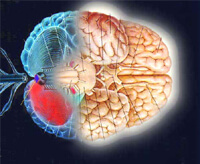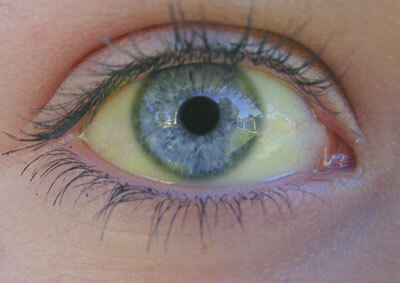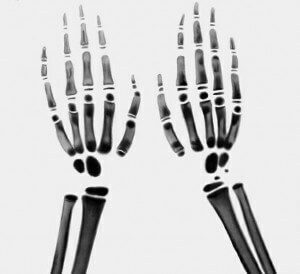Ataxia
 Ataxia( incoordination) - a violation of the coordination of the action( coordination) of various muscles, which is manifested by the disorder of targeted movements and static functions. Ataxia is a fairly common motor impairment, with the force in the limbs retained completely or rather slightly reduced. Movement becomes uncomfortable, inaccurate, there is a breakdown in their consistency and continuity, while walking and standing, the balance is disturbed.
Ataxia( incoordination) - a violation of the coordination of the action( coordination) of various muscles, which is manifested by the disorder of targeted movements and static functions. Ataxia is a fairly common motor impairment, with the force in the limbs retained completely or rather slightly reduced. Movement becomes uncomfortable, inaccurate, there is a breakdown in their consistency and continuity, while walking and standing, the balance is disturbed.
To adequately perform absolutely any movement, a joint concerted work of a large number of muscle groups is necessary. Movement itself is provided by mechanisms regulating the choice of the appropriate muscle groups, the duration and strength of individual muscle contractions and the sequence of their inclusion directly into the motor act itself. In the absence of coordination of muscle-antagonists and synergists, the quality of movement changes with the loss of its proportionality and accuracy. Movements become intermittent, lose their smoothness, become awkward and excessive. The transition between the movements( for example, flexion-extension) is much more difficult. Such discoordination of movements is called locomotor( dynamic) ataxia
. The following ataxia species are clinically distinguished:
→ Cortical( frontal) ataxia affects the cortex of the frontal or occipital-temporal region
→ Vestibular ataxia - the vestibular apparatus
is affected → Cerebellar ataxia - the cerebellum is affected
→ Zadnestolotbova( sensitive) ataxia - conduction of deep-muscular sensitivity
is disrupted. Frontal ataxia
This disorder is observed in the case of lesion of the frontalOle cerebri with damage to the bridge-lobular-cerebellar connections. The most severe disease manifests itself in the contralateral foci of limb injury( leg), characteristic disturbances of balance are observed, sometimes reaching the degree of astasia-abasia, a decrease in intelligence, memory and criticism. Ataxia can develop as a consequence of the following neurological diseases: abscesses and brain tumors, funicular myelosis, multiple sclerosis, polyneuropathies, idiopathic and hereditary cerebellar ataxia, craniocerebral trauma, stroke, etc. In addition, this genetic disorder can develop with chronic or acute alcohol intoxication, Vitamin E deficiency, poisoning with solvents and heavy metal salts, hypothyroidism e , with some medications( diphenin, carbaazepin et al.)
vestibular ataxia
This disorder develops in the affected peripheral vestibular apparatus is shown equilibrium and disorders in sitting, standing and walking. Vestibular ataxia is manifested by dizziness( sensation of rotating surrounding objects), which are strengthened by movements of the head;In some cases, nausea and vomiting are observed, the muscular-joint feeling is preserved, there are no disturbances in the limbs.
Cerebellar ataxia
As can be seen from the name, this disorder occurs in lesions of the cerebellum, as well as its pathways and is manifested by ataxia on standing( expressed in widely spaced legs) And walking, dysmetry in the performance of any precise movements, dysdiadochokinesis( a person can not quickly change one movement to another), tremor in the limbs, asynergia( inconsistency of movements).When the cerebellar form of the disease is often observed a change in handwriting( macro, unevenness), speech by warehouses( "chopped speech"), muscle hypotension, nystagmus. Damage to the cerebellar worm leads to ataxia of the trunk, cerebellar hemisphere damage to ataxia of homolateral limbs
Sensitive ataxia
This condition develops in the event of damage to the conductors or receptors of the musculo-articular sensitivity at any site in the posterior roots, the brainstem, peripheral nerves, the visual hillock and the posterior columns of the spinal cord. Sensitive ataxia is manifested by abnormalities of gait, balance, defeat of limbs( when performing precise movements, a person misses), muscle-joint feeling decreases;When closing the eyes, the degree of sensitive ataxia is significantly increased( Romberg's test).Ataxia manifests itself in characteristic muscular hyporeflexia and hypotonia, when walking, the patient inconsistently bends and unbends his legs, while striking the floor with a heel( "punching" gait)
Ataxia Friedreich
This type of disease develops at a frequency of about 5A person per 100,000 population. Most often the disease develops in 10 - 15 years( not later than 25 years).Due to damage to the spinal cord and the cerebellum, a progressive sensitizing and cerebellar ataxia is characteristic. Often there are skeletal anomalies( high arch of foot, kyphoscoliosis), light central paresis of limbs, defeat of the heart muscle. For Friedreich ataxia, the degree of progression is different, but most patients die before they reach the age of thirty.
Hereditary idiopathic cerebellar ataxia
This type of ataxia develops in people over 25 years old, and its genesis is unclear. The first type of this disease manifests itself in progressive cerebellar ataxia. The second type is characterized by a combination of ataxia with central paresis, symptoms of autonomic nervous system damage( orthostatic hypotension) and basal ganglia.
Congenital ataxia
This condition is associated with aplasia of the cerebellum and is often combined with other congenital malformations. The main syndrome is non-progressive cerebellar ataxia. Often with congenital form, there is a good development of independent walking, motor skills, the ability to learn and self-service
Diagnosis of ataxia often does not cause difficulties and is based on the presence of typical clinical manifestations. The diagnosis is confirmed by the results of immunological examination of cerebrospinal fluid and blood. In addition to confirming the diagnosis, CT and MRI of the head are indicated. In case of suspicion of hereditary nature, a genetic examination is performed.
Rapidly increasing symptomatology of the disease is most often due to brain abscess, tumor, chronic alcohol intoxication or multiple sclerosis. The acute development of ataxia in most cases is caused by acute disorders of cerebral circulation in the cerebellum( infarction, hemorrhage, etc.).Episodic ataxia most often develops as a consequence of taking certain medicines( diphenin, carbamazepine), with multiple sclerosis, episodic hereditary ataxia. Slowly progressing ataxia develops in idiopathic and hereditary degenerative forms of the disease and multiple sclerosis.
Treatment of ataxia is symptomatic in most cases and is based on the therapy of the underlying disease. Idiopathic degenerative and hereditary forms of treatment are not subject to treatment. In addition, the social rehabilitation of the patient and the complexes of therapeutic gymnastics are of no small importance in the treatment.
Ataxia prognosis is malogamous. The patient has a gradual progression of various neuropsychic disorders. In most cases, work capacity is markedly reduced. Even so, in case of prevention of intoxications, injuries, repeated infectious diseases and the timely conduct of adequate symptomatic treatment, patients can successfully survive to old age.
Prevention of ataxia is the exclusion of any possibility of related marriages. In addition, families where there are diagnosed patients with hereditary ataxia are not recommended to have children.



